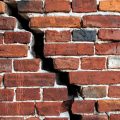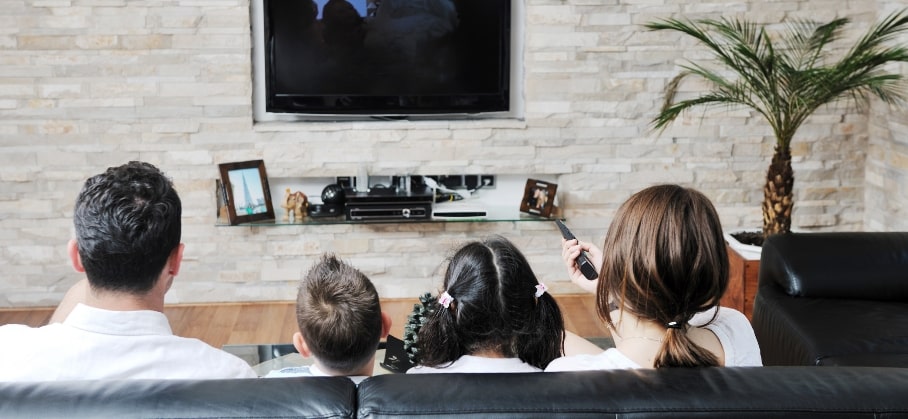
Mounting the TV on the wall is an excellent option if you want to save some space or just don’t have any for a TV table and cable boxes. The wall mounting is the best choice if you want to keep the TV away from children.
Choosing the right TV brackets is more complicated than it sounds. You need to take a lot of important factors into consideration first.
Don’t worry, though. We answered all of the questions you need to ask yourself in this article.
How do you know if your TV can be wall mounted?
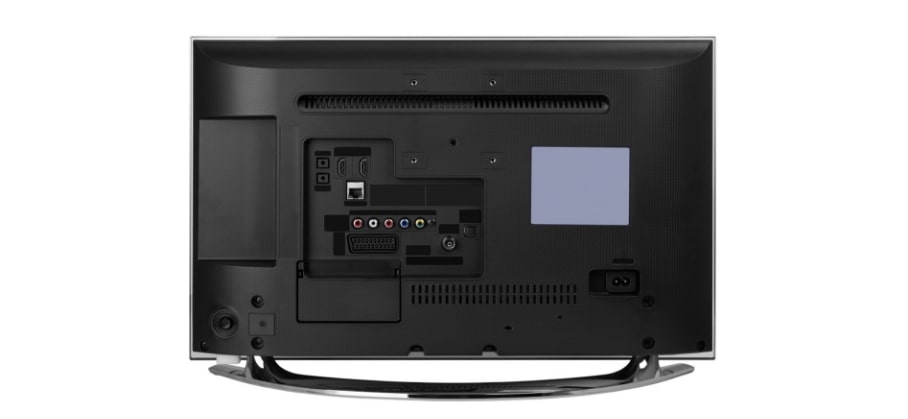
The majority of flat-screen TVs are designed to be wall-mounted. They are light and have holes in the back where the brackets should fit. Before buying a certain TV, check for a “VESA” sign on it.
This means that the TV follows the Video Electronics Standards Association set guidelines for a standardized TV wall mount. Even if the TV doesn’t follow these standards, it should be marked if it can be used with wall brackets. You can simply check the back of the TV for four symmetrical holes.
Do all TV wall mounts fit all TVs?
Not all wall mounts can fit with all types of TVs. The TV brackets should fit the hole pattern on the back of the TV to work.
Most of the TVs use a standard mounting pattern, called a VESA size.
What is a VESA size?
As we said, VESA (Video Electronics Standards Association) sets certain guidelines to standardize the sizes of the wall mounts to make it easier for consumers to find the best type of TV brackets without a hassle. Every wall mount with the same VESA number will fit with any TV with the same number.
However, some TV manufacturers choose to ignore these standards, so the holes in the back may be positioned differently. Usually, if this is the case, they may also produce TV brackets to go along with the TVs. Some companies produce adjustable brackets that can fit any holes easily.
How to measure your VESA size?
You can find the VESA size in the manual instructions of the TV or check it up online. But even if you can’t find it, the VESA size is easy to measure. You basically need to measure the horizontal distance and the vertical distance. The VESA size is those two numbers written, the horizontal first (200×100, for example)
Most of the hole patterns in the TV backs are square – the horizontal equals the vertical, but there are some rectangular patterns as well. Your goal is to choose TV brackets that follow the same patterns to ensure the TV will be well fitted and secured on the wall.
What are the different types of TV wall mounts?
There are countless variations of wall mounts types and models. But there are only a few basic styles. They mainly differ in how flexible they are, how much you can adjust the screen position and how much they cost.
Low-profile TV brackets

Low-profile brackets are the easiest to install and lowest-cost type of wall mounts. The brackets can hold heavy TVs. The TV is parallel to the wall, and it’s positioned closely.
This type of bracket are perfect if you’re planning to sit straight against the TV because the mount is fixed, it doesn’t have angle adjustments, and you can’t tilt it. That’s why you need to plan the exact position carefully before installing. Mount it in a way that you’ll feel comfortable looking at the TV without bending your neck.
On the other hand, the inability of the mount to be moved makes access to the TV ports hard if they’re located on the back of the TV. You have to physically remove the TV every time to plug or unplug cables.
Tilting TV brackets
The tilting TV brackets are a bit expensive compared to the low-profile brackets. The wall mount is easy to install, and the TV is positioned further from the wall, making it easy to reach ports and cables on the back.
The main difference between the two types of brackets is that the tilt mount allows you to adjust the TV vertically and adjust the viewing angle. This is the perfect solution if the TV is positioned higher on the wall. You can also tilt the TV down to avoid screen glare and reduce reflections.
Full-motion TV brackets
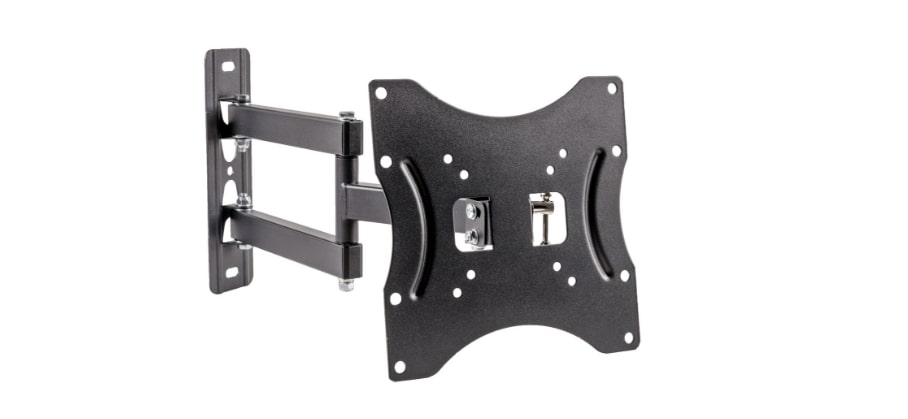
The full-motion wall brackets offer great flexibility in changing the position of the screen. It allows the TV to be angled vertically and horizontally to provide the optimal viewing angle. To move the TV horizontally, you need to move the TV away from the wall. You can also pull the TV closer by moving its arm. The cords are easily reachable, so this is the best choice if you have other devices such as consoles, sound systems etc.
These types of brackets are perfect for rooms with more than one viewing angle. Full-motion mounts are the most expensive option and are more complicated to install. This type of bracket has moving parts, and it’s impossible to be mounted by just one person.
Ceiling TV brackets
Ceiling brackets offer the best solution if you don’t have free wall space or if the wall material doesn’t allow you to mount a TV. The brackets are mounted on the ceiling, and the TV hangs from it. This type of bracket allows the screen to be easily adjustable and moved around 360-degree horizontally.
You should consider the weight of the TV and check the specification on the manual instruction of the brackets to make sure they can hold the heaviness of the TV.
Need help with mounting your TV on the wall?
Book a TV wall mounting service
You can book our handyman services in Melbourne, Sydney, Brisbane and Perth!
Important things to consider before choosing TV brackets
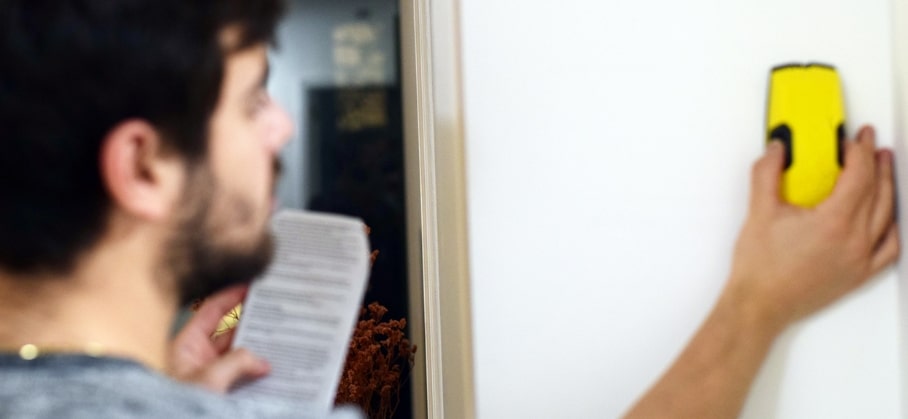
Before getting into choosing TV wall mounts, you need to take some important things into consideration first. Examine the space you’ll be installing objectively. Ask yourself the following questions before proceeding.
Follow the TV’s specifications
The TV brackets are designed to fit a specific type of TV, and the weight and the size matter. If the wall mount can only support a 33-inch TV, you shouldn’t try to fit a 44-inch one. Eventually, it’ll fall down.
Before choosing TV brackets, be sure to read the TV’s specifications and buy a wall mount that can support the weight and the size of the TV.
Is the wall strong enough to support the heavy TV?
Before anything else, first, you need to consider whether the wall could handle the TV. Modern flat TVs are way thinner and lighter compared to the old bulky TVs, but they’re still heavy.
Nowadays, most TV brackets are produced in a way that makes them compatible with almost all types of walls – drywalls and brick walls included. The TV mounts usually come with a package with the hardware you’ll need to install it. Read the specification of the wall mount, so you’ll know if it’s compatible with your wall type.
The exact weight varies between models and brands. Even TVs of the same size can weigh differently. For example, the weight of a 55 inch TV can vary between 15-50 kg. The wall should be able to support its weight every day, without the TV ending down on the floor. The TV bracket’s specification will also include the maximum size and weight that the brackets can carry.
Studs are vertical boards that function as a support of the wall. They are usually placed between 40-60 cm from each other.
If there are no studs in the area in which you want to install the TV, don’t decide to drill onto the wall. This is a fine solution for artwork and small shelves, but the wall won’t support a heavy TV for a long time. If that’s the case, reconsider the wall mount location in the room.
What other components you want to install?
Are you planning to install just a TV? What other components do you want to use? Most of the people are also installing devices such as sound systems, gaming consoles, DVRs etc.
If that’s your case, you need to plan space for them as well. They need to be close to the TV and an outlet, easily accessible cords which go in the TV hookups.
Pick a place with open shelves or consider installing floating shelves. The easiest solution is to place a bookshelf or a TV table underneath.
Where are the TV ports located?
Various brands design their TVs differently. That means that their ports are all over the place. Some are located on the left, some on the right, some on top, some on the bottom.
You have to choose TV brackets according to where the important ports are located. Most of the TVs (but not all of them) have their ports located in the back. If that’s the case, you’ll need to pick a wall mount that allows the TV to be moved forward and backward so you can plug and unplug other devices.
What about the TV cords?
Sure, you don’t want to see tangled cords running across your wall after mounting the TV. If you have other devices as well, it can turn into a true hell.
Consider options to hide away the cords. The easiest solution is to place the cords inside a TV table, box or shelf. If you plan to keep the TV mounted permanently, you can hire a professional to hide the cords in a box inside the wall.
Think about this matter before rushing to buy TV brackets so that you can enjoy the view without visible cords.
What is the optimal viewing angle?
Another important decision you need to make is to choose a TV size that will fit your needs. For achieving a great experience, the recommended viewing angle from the Society of Motion Picture & Television Engineers (SMPTE) recommends sitting in a place where the screen fills around 30°- 40° of your vision. Sitting at such a distance will create a cinematic experience but also won’t hurt your vision.
Before mounting the TV, you need to consider the layout of the room and the viewing position. Are you going to watch the TV from the couch? If yes, don’t mount the TV too high because the viewing angle will be uncomfortable. Avoid mounting the TV across windows or glass doors because the sun’s glare will interfere with the picture. If that’s not possible, you can install curtains so that you can enjoy the bright picture during the day.
How do you want to move the TV after mounting it? You also need to consider the flexibility you want the TV to have to achieve the optimal viewing angle. Different types of brackets offer different types of motion and flexibility. Some can tilt up and down, some side to side. Some can move in all directions.
Need help with mounting your TV on the wall?
We can help you with that!
You can book our handyman services in Melbourne, Sydney, Brisbane and Perth!
Takeaways
To summarize, when it comes to selecting TV brackets, you should consider more than just the price and the perks of the wall mount. You should pay attention to the wall material, the layout of the room and think about where do you want to be sitting while enjoying the TV. Having all this in mind will contribute to the most suitable option for your specific situation.
After you’re done, all you need to do is sit comfortably and enjoy your favourite movie.
